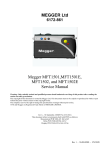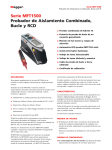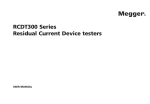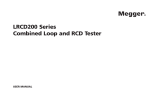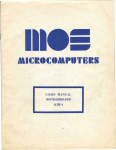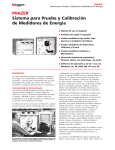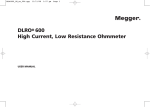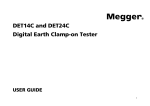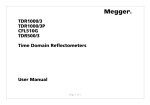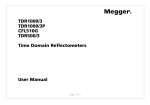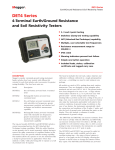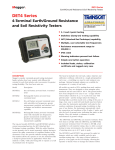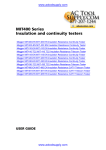Download MFT1500 Series Multifunction Tester
Transcript
M MFT1500 Series Multifunction Tester USER MANUAL G SAFETY WARNINGS ■ Safety Warnings and Precautions must be read and understood before the instrument is used. They must be observed during use. ■ The circuit under test must be switched off, de-energised and isolated befor e test connections are made when carrying out insulation and continuity tests. ■ Continuity of protective conductors and earthed equipotential bonding of new or modified installations must be verified before carrying out an earth fault loop impedance test, or RCD test. ■ Circuit connections and exposed metalwork of an installation or equipment under test must not be touched. ■ The live circuit warning and Automatic discharge are additional safety features and should not be regarded as a substitute for normal safe working practices. ■ Do not change the rotary switch positions while a test is in progress. ■ The LCD ‘neon’ voltage indicators cannot reveal a Neutral - Earth reversal. They cannot be relied upon to identify circuit correctness and are for guidance only. ■ After insulation tests, capacitive circuits must be allowed to discharge befor e disconnecting test leads. ■ The instrument should not be used if any part of it is damaged. ■ Test leads, probes and crocodile clips must be in good order, clean and with no broken or cracked insulation. ■ Ensure that hands remain behind guards of probes/clips when testing. ■ UK Safety Authorities recommend the use of fused test leads when measuring voltage on high energy systems. ■ Replacement fuses must be of the correct type and rating. Failure to fit the correctly rated fuse will result in damage to the instrument in the event of an overload. ■ The battery cover must be in place whilst conducting tests. NOTE THE INSTRUMENT MUST ONLY BE USED BY SUITABLY TRAINED AND COMPETENT PERSONS. Users of this equipment and/or their employers are reminded that Health and Safety Legislation requires them to carry out valid risk assessments of all electrical work so as to identify potential sources of electrical danger and risk of electrical injury such as inadvertent short circuits. Where the assessments show that the risk is significant then the use of fused test leads constructed in accordance with the HSE guidance note GS38 'Electrical Test Equipment for use by Electricians' should be used. 2 CONTENTS Safety Warnings Description Overview of MFT1500 Series Instrument Layout Display Control Panel Front switch panel Connection panel Test Leads Battery /fuse warning, fitting and replacement Operation General operation Live circuit warning Test button lock Backlight (MFT1502 only) Auto shut-off Polarity indication Illuminated Switched Probe Operation Voltage measurement (V) Continuity Continuity measurement Lead Null Continuity Buzzer Buzzer threshold Insulation Insulation resistance Insulation Voltage ranges Test lock Loop impedance NO TRIP (15mA) loop test High Current Loop test 2 4 4 4 4 4 4 4 4 5 6 6 6 6 6 6 6 6 6 7 7 7 8 8 8 8 8 8 9 9 P-N and P_P loop test PSC Residual Current Device (RCD testing) 1/2I, I, 5 x I, 0 & 180° 14 Ramp testing DC Sensitive RCDs 15 Technical specification 16 Accessories 19 Repair and Warranty 20 Symbols used on the instrument are: F G t G Caution: risk of electric shock Caution: refer to accompanying notes Equipment protected throughout by Double Insulation (Class II) c Equipment complies with current EU directives. >500V Maximum nominal system voltage of 500 V Max 300 V CAT III g Maximum 300 V a.c. CAT III to Earth 3 DESCRIPTION Thank you for purchasing the MFT1500 Multifunction Tester. The MFT1500 series of tester is compact and designed to perform all of the functions required by the electrical contractor to fully test domestic, commercial and industrial wiring. Specially designed to comply with UK, European and other International wiring regulations and standards, the MFT1501 and MFT1502 may be used on all single and three phase systems with rated voltages up to 300 Volts a.c. rms to earth/ground. All test leads supplied with the MFT1501 and MFT1502 form part of the measuring circuit of the instrument and must not be modified or changed in any way, or be used with any other electrical instrument or appliance. Test selection Display Battery cover (side panel) Connection indicators Contact A plug severed from the power cord MUST be destroyed, as a plug with bare conductors is hazardous in a live socket outlet. Ohms Null OVERVIEW OF MFT1500 SERIES RCD range selection Noise warning Fuse warning Battery status Temperature warning ORANGE (BUZZER THRESHOLD) BLUE (0º - 180º) YELLOW (TEST BUTTON) BLACK (BACKLIGHT) Warning RED (TEST LOCK) Continuity and insulation connections Switched probe 4 LOOP & RCD connections Mains plug test lead REPLACING FUSES AND BATTERIES Battery and Fuse fitting/Replacement Battery type: 8 x 1.5 V Alkaline LR6 (AA) Fuse type: 500 mA (F) HBC 10 kA 500 V Low battery warning symbol Fuse blown symbol To replace the fuse Should the main fuse fail, the symbol will be displayed. Disconnect the instrument from any circuits. Remove the battery cover as above. To test battery condition With the MFT1500 switched to the OFF position, press the RED test lock and the YELLOW TEST button together. The battery voltage is displayed. If the battery symbol also appears the batteries need replacing. L The blown fuse should be replaced with a 500 mA (F) HBC 10 kA 500 V fuse (Megger part no.25950-039) Replace the battery cover. To replace batteries Switch off the instrument and disconnect (the instrument) from any electrical circuits. Remove the battery cover. Slide out the battery clip and remove the dead cells. Refit new batteries following correct polarity as marked on the battery holder. Replace the battery holder and cover. Note: - Incorrect battery cell polarity can cause electrolyte leakage, resulting in damage to the instrument. 5 OPERATION GENERAL OPERATION Note: These functions are generally apply and not limited to an individual test function. Polarity Indication If connected to a single-phase power supply by a plug or by the 3-wire lead set, three LCD ‘neons‘ marked L-PE, N-PE and L-N respectively will indicate supply polarity. Live circuit warning - Test Inhibit Testing is automatically inhibited if: During insulation testing - an external voltage >55 V is present on the terminals L-PE N-PE L-N During continuity testing - a voltage >10 V is present on the terminals Correct supply indication During RCD or No-Trip loop testing - a voltage >270 V is present Live –Neutral swapped During Loop testing - a voltage >480 V is present Test button lock To lock the test button hold down the RED holding down the YELLOW TEST button. L test lock button whilst Intelligent Backlight (MFT1502 only) Both the display and range knobs have a backlight. To activate, press the BLACK button. J To disable the Intelligent backlight function, press the BLACK button and the RED lock button together. L J Repeat to enable the intelligent backlight. Instrument Auto shut-of f Automatically activated after 5 minutes of instrument inactivity. To restore operation press the RED lock button or switch the instrument off and on. 6 If a voltage is detected between their respective two wires, the ‘neon’(s) will activate. Any other combinations should be investigated further. However the LCD 'NEONS' cannot be relied upon to identify circuit correctness and are for guidance only. Note: - The presence of a voltage between phase and earth does not prove earth continuity, as the earth could have a high resistance and a voltage would still be measured. To test earth continuity refer to the sections on loop resistance or RCD testing. Warning: The LCD 'Neons' are invalid when using the two wire lead-set and should be ignored. ILLUMINATED SWITCHED PROBE SPL1000 (MFT1502 ONLY) The Illuminated switched probe accessory replaces the RED 4 mm test lead. It can be used anywhere that the 4 mm lead set is specified in this user guide. Operation The YELLOW button duplicates the function of the TEST key on the instrument, allowing quick and easy testing. The BLACK switch operates a white LED, which illuminates the probe tip for use when testing under low light levels. There is also a visual indication via a red/green LED to notify the user of the display status, the meanings are as follows: OR Using the Mains plug Lead set (OPTION3) Voltage between the L and E pins is displayed Note: - When connected to the circuit under test the instrument will automatically display AC or DC voltage measurement up to 500 V. Green : A valid result is present on the display or the continuity buzzer is buzzing. This function will continue to work if the fuse is blown. Red: A warning is being shown on the display, testing will be inhibited. CONTINUITY Warning: Prior to any continuity testing, ensure the circuits under test are isolated and not live VOLTAGE MEASUREMENT [V] TEST LEAD CONNECTION Z TEST LEAD CONNECTION OPTION 1 OPTION 2 OPTION 3 OPTION 1 OPTION 2 2 wire lead Switched Mains plug 2 wire lead Switched set probe test lead L-E set probe BLACK BLACK BLACK BLACK RED RED PROBE PLUG Set the Rotary range knob to the [V] range (The position of the right hand ‘mA’ rotary range knob does not matter) Two wire lead set or Switched Probe connection Using the 2-wire lead set OPTION 1 or OPTION 2 1. Connect the test leads as shown. 2. DC Voltage (V) or AC Voltage (V~) is automatically displayed. PROBE Set the left hand rotary range knob to the Ω range required. (The position of the right hand rotary range knob does not matter). Continuity measurement can be made using one of the 2 options shown above. A continuity measurement is made automatically when the test leads are connected to the circuit under test. The contact symbol on the display closes when a resistance of approximately 200 kΩ or less is detected. 7 Lead Null (up to 9.99 ) Short test probes or clips together and press the YELLOW TEST button on the instrument (or on the switched probe if fitted). The will be displayed to indicate lead null is active. z This null value is stored until the YELLOW TEST button is pressed again. To cancel the LEAD NULL, press the YELLOW TEST button. Continuity Buzzer Z Test leads OPTIONS 1 or 2 above 200 mA when measuring 2 Ω. Possible sources of error Measurement results can be affected by the following: ■ The impedance of operating circuits connected in parallel. ■ Impedance such as inductors that vary during the measurement. ■ A poor connection to the circuit under test, which can give readings as much as 100 mΩ (0,10 Ω) high. The best way to avoid this error is to use sharp prods and press these firmly into the conductors being measured. The MFT1500 buzzer will sound continuously if the resistance between the leads is less than a set limit (Default value 2 Ω). INSULATION RESISTANCE [MΩ] [250 V] [500 V] [1000 V] Warning: Prior to any insulation testing, ensure the circuits under test are isolated and not live. If being used with the illuminated switched probe (OPTION 2) continuity is also indicated by a GREEN LED on the probe. TEST LEAD CONNECTION To turn off the buzzer press the TEST button whilst in BUZZER mode. The display will indicate ON or OFF status. Buzzer threshold The resistance at which the buzzer stops sounding can be changed to meet individual test requirements. Press the ORANGE button to select the resistance limit. Z Selectable limits of 2 Ω, 5 Ω, 10 Ω, 20 Ω, 50 Ω and 100 Ω. OPTION 1 OPTION 2 2 wire lead Switched set probe BLACK BLACK RED PROBE Set the left hand rotary range knob to the required INSULATION Range. This setting is stored even when the instrument is switched off. 250 V Insulation measurement to 99.9 MΩ Notes:Method of measurement The 2-wire lead set must be used for this measurement. The instrument produces a d.c. voltage of nominally 4,5 V with a current limit of at least 500 V Insulation measurement to 299 MΩ 8 1000 V Insulation measurement to 499 MΩ (The position of the right hand rotary range knob does not matter.) with a circuit capacitance up to 5 µF. To initiate insulation testing press and hold the YELLOW TEST button on the instrument or the switched probe if connected. LOOP IMPEDANCE [LOOP] TESTING Loop impedance measurement can be made via installation sockets using the plug terminated test lead, OPTION 3, or at any other convenient point on the installation using a two/three wire lead set, OPTION 1 OR 2. Release the test button after the displayed reading has settled. TEST LOCK To lock down the test button press the YELLOW TEST button followed by the RED LOCK button. L A warning triangle G will appear in the display while the test lock is active. Press the YELLOW TEST button to stop the test. Note: - A 1000 V warning is displayed whenever the 1000 V range is selected and the test button pressed The MFT1501 and MFT1502 will measure the loop resistance from the supply end of the standard test leads, allowing for their resistance. NON TRIPPING LOOP TESTS [NO TRIP] Set the LEFT rotary range knob to the required LOOP range as described below: OPTION 3 OPTION 1 OPTION 2 3 wire Switched Mains plug measurement Probe test lead Warning: The test voltage will be permanently present on the test probes or crocodile clips when in the locked modes. BLACK BLACK GREEN GREEN Notes: - Auto discharge - Auto discharge facility automatically and safely discharges connected circuit after test via 250 kΩ resistor. RED Live circuit warning - operates when connected to Live circuits > 25 V. Test Inhibited - an audible alarm operates at >55 V. The instrument will not perform a test until the voltage source has been removed. Method of measurement A current limited (2 mA) d.c source is used, and the resistance is calculated from measurements of the voltage and current. PROBE PLUG (The position of the right hand rotary range knob does not matter.) [NO TRIP] LOOP-TESTING - SINGLE PHASE TESTING ONLY The NO TRIP loop test is a high resolution low current earth loop resistance measurement (Loop L-PE 0.01 Ω) range which does not trip RCDs with a rated current 30 mA or higher. The voltage is only present when the test button is pressed or the test lock is active. A measurement of the terminal voltage is made before the test and if this exceeds 55 V the test is disabled. The reading is stable 9 [NO TRIP] PHASE TO EARTH LOOP IMPEDANCE MEASUREMENT (AT A POWER SOCKET) Test Lead set: OPTION 3 OPTION 2 2 wire lead Switched Mains plug set probe test lead 1. Select NO TRIP Loop test range. 2. Insert the plug into an installation socket. GREEN 3. Supply voltage and polarity are displayed. RED 4. The test will ‘beep’ and automatically start when voltage is detected. 5. Measured loop value is displayed If desired the test can be repeated by pressing the YELLOW TEST button. [NO TRIP] EARTH LOOP IMPEDANCE MEASUREMENT (NOT AT A POWER SOCKET) Test Lead set: OPTION 1 or OPTION 2 1. Firmly connect the GREEN lead to EARTH, the BLACK lead to NEUTRAL and the RED lead to PHASE. 2. Perform the loop test, as above for power socket. If desired the test can be repeated by pressing the YELLOW TEST button. HIGH CURRENT LOOP-TESTING [25 A] Single Phase and Phase to Phase loop testing on circuits that are NOT protected by RCD GREEN PLUG PROBE Set the instrument to the [25 A] Loop test range 25 A Phase to Earth loop impedance measurement (at a power socket): Test Lead set: OPTION 3 1. Insert the plug into an installation socket. 2. Supply voltage and polarity are displayed. 3. The test will ‘beep’ and automatically start when voltage is detected. 4. Measured loop value is displayed. If desired the test can be repeated by pressing the YELLOW TEST button. 25 A Phase-Earth loop impedance (not at a power socket): Test Lead set: OPTION 1 or 2 1. 2. 10 OPTION 3 OPTION 1 Connect the GREEN lead to EARTH and the RED lead to PHASE Supply voltage is displayed. Warning: The LCD 'Neons' are invalid when using the two wire lead-set and should be ignored. 3. The test will automatically start when voltage is detected. 4. Measured loop value is displayed. If desired the test can be repeated by pressing the YELLOW TEST button. BONDED METALWORK TESTING Test Lead set: OPTION 1 or 2 1. Connect the GREEN lead to the bonded metalwork. 2. Connect the RED lead to PHASE. 3. Supply voltage is displayed. PHASE-NEUTRAL OR PHASE-PHASE LOOP IMPEDANCE Test Lead set: OPTION 1 or 2 1. Connect the GREEN lead to NEUTRAL and the RED lead to PHASE (or the 2nd PHASE for Phase to Phase loop measurement). 2. The supply voltage is displayed. Warning: The LCD 'Neons' are invalid when using the two wire lead-set and should be ignored. 3. The test will automatically start when voltage is detected. 4. Measured loop resistance is displayed. If desired the test can be repeated by pressing the YELLOW TEST button. Warning: The LCD 'Neons' ar e invalid when using the two wire lead-set and should be ignored. 4. The test will automatically start when voltage is detected. 5. Measured loop value is displayed. If desired the test can be repeated by pressing the YELLOW TEST button. 11 PROSPECTIVE SHORT CIRCUIT CURRENT [PSC] OPTION 1 OPTION 2 2 wire measurement Switched PHASE TO NEUTRAL PSC As for the 25 A Phase to Earth PSC test but with the following test lead connections: probe 1. Connect the GREEN lead to the NEUTRAL and the RED lead to PHASE. 2. The test will ‘beep’ and automatically start when voltage is detected. 3. Measured PSC value is displayed. GREEN GREEN RED PROBE Set the instrument to the [PSC] range PSC is a 25 A two wire test. PHASE TO EARTH PSC Test Lead set: OPTION 1,2 1. For Single phase measurement connect the test leads as shown above. Notes :The PSCC of a circuit is the largest Prospective Fault Current (PFC). In a single phase system, this would be the larger of the earth loop PFC and the neutral loop PFC. In a multi-phase system phase-phase loops also need to be considered and these can be measured using the Loop 25A switch position. The PSC is calculated by using the sum:Nominal supply voltage PSC = For Phase to Phase measurement connect the GREEN lead to the 2nd Phase. 2. Supply voltage and polarity are displayed. 3. The test will ‘beep’ and automatically start when voltage is detected. 4. Measured PSC value is displayed. If desired the test can be repeated by pressing the YELLOW TEST button. 12 Loop resistance The supply voltage used in the calculation depends on the measured voltage. The instrument uses the following voltage values:Actual measured voltage Nominal voltage > 45 V and < 80 V 55 V >80 V and <150 V 110 V >150 V and <300 V 230 V >300 V 400 V PSC measurement accuracy An accurate PSC measurement requires an accurate measurement of the loop resistance. The difference of a few digits in the loop resistance measured will have a large effect on the PSC displayed. Noise Indication The symbol is displayed when excessive noise caused by other equipment exists on the circuit under test. This noise can effect the accuracy of the loop measurement. The operator is advised to repeat the measurement or, if the noise symbol continually appears, investigate the cause. Method of measurement The phase-earth, phase-neutral or phase-phase loop resistance can be measured. The instrument takes a current from the supply and measures the difference between the unloaded and loaded supply voltages. From this difference it is possible to calculate the loop resistance. The test duration will depend on the loop resistance value and the presence of noise on the supply. The NO TRIP loop test range performs a test with a current of up to 25 A flowing Line to Neutral to measure the resistance of the source and line wires, followed by a current of 15 mA flowing Line to Earth to measure the resistance of the earth wire . the Phase-Earth loop is being measured, this leakage may be due to filter capacitors, etc. Test results may be adversely affected by supply voltage fluctuations or electrical ‘noise’ during a measurement. It is recommended that tests are repeated and the results verified, if measurement results are considered abnormal. Errors can be reduced by:The two-wire lead set with prods and make a firm connection to clean conductors. ■ ■ Several tests and take the average value. ■ Ensure that potential sources of noise in the installation are isolated (switched off), eg: automatically switched loads or motor controllers ■ Ensuring that the instrument is calibrated. Thermal Protection To protect the MFT1501 and MFT1502 from overheating during Loop testing, thermal protection is fitted. If the message ‘HOT’ appears in the display when loop testing, the instrument must be allowed to cool down before further attempts are made at loop testing. Possible sources of error The reading depends on a measurement of the supply voltage and therefore noise or transients caused by other equipment during the test could cause an error in the reading. One way to check for these is to do two tests and look for any difference in value. The instrument will detect some sources of noise and warn the user, where other instruments may give an incorrect reading. Any leakage current as a consequence of other appliances connected to the supply under test may affect the reading. If 13 RESIDUAL CURRENT DEVICE [RCD] TESTING OPTION 1 OPTION 2 2 wire lead Switched Mains plug set probe test lead GREEN Note: The Breaker symbol indicates whether the test function selected is a NON-TRIPPING or TRIPPING test: OPTION 3 CLOSED = NON-TRIPPING test OPEN = TRIPPING test GREEN 1/2 I RCD Testing Set the LEFT [RCD] rotary range knob to the [ 1/2I ] RCD test range. RED PROBE PLUG The MFT1501 and MFT1502 can perform the following RCD tests: 1/2I Non-tripping test at half the rated RCD trip current for 2 seconds, during which the RCD should not trip. I Tripping test at the rated RCD trip current. The trip time will be displayed. 5I Tripping test at 5 x the rated RCD trip current. The trip time will be displayed in milliseconds. DC Tripping test for DC Sensitive RCDs 0 or 180° Some RCDs are sensitive to the polarity of the supply, i.e whether the test current is applied with the instantaneous voltage rising or falling. Trip tests should therefore be performed with both polarities 0° and 180° and the maximum time recorded. Ramp Test Used to check the trip current of an RCD. 14 Set the RIGHT [mA] rotary range knob to current rating of the RCD under test. Test lead set: OPTION 1, 2 or 3 1. Ensure the right hand Rotary knob is set to the correct range for the RCD under test. 2. Press the YELLOW TEST button. 3. After 2 seconds the message >1999 ms is displayed. If the RCD trips unexpectedly the message ‘trP’ will be displayed. 1 x I RCD Testing Set the LEFT [RCD] rotary range knob to the [ I ] RCD test range. 1. Press the YELLOW TEST button. 2. The RCD trip time is displayed. 3. If the RCD fails to trip, >200 ms is displayed (indicating a failed test). 5 x I RCD Testing Set the LEFT [RCD] rotary range knob to the [ 5I ] test range. 1. Press the YELLOW TEST button. 2. The trip time will be displayed. 3. If the RCD fails to trip, >40 ms is displayed (indicating a failed test). RCDs, these should be tested with 0° and 180° polarity. Note: - The instrument can only test up to 1 A a.c. or 300 mA d.c. Any tests that exceed these limits are disabled. 0 or 180° testing 0° or 180° is selected by pressing the BLUE button on the side of the MFT1501/1502 on either the 1/2I, I , 5I or DC RCD test. The I, 5I and DC RCD tests should be performed at 0° and 180° and the greater trip time recorded. RAMP TEST The RCD trip current is measured by applying a test current of half the rated trip current and increasing this every 200 ms. When the RCD trips, the current flowing is recorded and displayed in mA. To determine the trip current of an RCD. 1. Select the appropriate RCD rated current on the right hand rotary switch. 2. Select the [DC] test on the left hand range knob 3. Press the YELLOW TEST button 4. The trip time will be displayed in ms. 6. If the RCD fails to trip, ">200 ms" will be displayed. Method of measurement The two wire lead or plug should be used for this measurement. A constant current source is connected across the supply and the time taken for the supply to trip is measured by the instrument in ms. Possible sources of error Measurement results can be affected by the following: 1. Select the appropriate RCD rated current on the right hand rotary switch. ■ Significant operating errors can occur if loads, particularly rotating machinery and capacitive loads are left connected during tests. 2. Select the RAMP ■ A poor connection to the circuit under test. 3. Press the YELLOW TEST button 4. The trip current is displayed. 5. If the RCD fails to trip, ">***mA" will be displayed, where *** indicates the last test current applied. test on the left hand range knob. T Thermal Protection The RCD circuit has thermal protection fitted to prevent overheating in the event of multiple ramp tests being performed. The T symbol or the message "Hot" will be displayed. Allow the instrument time to cool down before continuing. DC SENSITIVE RCD TEST [RCD] D.C. sensitive RCDs are tested with a pulsed waveform. The RMS current is √2 x the rated operating current of the RCD. As with the normal 15 TECHNICAL SPECIFICATIONS Electrical specification Voltage range Loop ranges (to EN 61557-3) Line/Earth (Single phase) The voltage will enable the user to ascertain if a system is live prior to testing. Accuracy ±2% ±2 digits Supply 55 V - 270 V 45Hz to 65Hz 25 A 0.01 Ω - 9.99 Ω (±5% ±0.03 Ω) 10.0 Ω - 89.9 Ω (±5% ±0.5Ω) Voltage a.c. - 000 V - 500 V 50/60Hz 90 Ω - 899 Ω (±5% ±5Ω) Voltage d.c. - 000 V - 500 V (Indication of polarity above 10 V) 900 Ω - 3.00 kΩ (±5% ±20Ω) Insulation ranges (to EN 61557-2) Accuracy ±2% ±2 digits up to 99 MΩ EN 61557 Operating Range Short circuit current Line/Line(Three phase) <2 mA 1 mA at min. pass value of insulation specified in BS7671, HD384 and IEC364 250 V 0.01 - 99.9 MΩ 500 V 0.01 - 299 MΩ +20% - 0% at rated load or less. Auto discharge facility safely discharges connected circuit after test. Live circuit warning/inhibit when connected to live circuits (Threshold 55 V) 16 55 V - 480 V 45Hz to 65Hz 25 A 0.01 Ω -19.99 Ω (±5% ±0.03 Ω) (at 230 V) 0.25 Ω to 19.99 Ω Low current Loop (No Trip) 250 V, 500 V and 1 kV into 1 mA load EN 61557 Operating Range Supply EN 61557 Operating Range 1000 V 0.01 - 499 MΩ Output voltage 0.25 Ω to 3.00 kΩ 0.10 MΩ to 99.9 MΩ Supply 55 V - 270 V 45Hz to 65Hz 15mA 0.01 Ω - 2.00 kΩ (±5% ±0.03 Ω ± Noise Margin) (at 230 V) EN 61557 Operating Range 0.5 Ω to 2.00 kΩ Prospective Short-circuit Current (PSC) Prospective Short circuit current = Nominal Voltage / Loop Resistance Accuracy is therefore derived from the loop test. 1 A - 199 A 1 A resolution 0.02 kA - 1.99 kA 10 A resolution 2.0 kA - 19.9 kA 100 A resolution Continuity (to EN 61557-4) 0.01 Ω - 99.9 Ω (±2% ±2 digits) Ohms 100 Ω - 99.9 kΩ (±5% ±2 digits) EN 61557 Operating Range Buzzer 0.10 Ω to 99.9 kΩ Intrinsic Accuracy of ramp test current ±3% Trip time accuracy Remote Probe MFT1502 only (Optional on MFT1501) Torch featur e Open circuit voltage Test current 4 - 5 V d.c. >200 mA at 2 Ω Test Lead resistance zeroing Up to 9.99 Ω (zero uses Test Button) RCD ranges(to EN-61557-6) 5 mm White LED 1500 mcd Operates continuously at less than selected limit . Selectable limits of 2 Ω, 5 Ω, 10 Ω, 20 Ω, 50 Ω, 100 Ω ±1% ±1 ms Safety CLASS 1 LED to IEC 60825:2001 Interchangeable tips Lengths 30 mm GS38 112 mm GS38 Battery 9 V PP3 Red/Green LED RED indicates that the instrument is displaying a warning (eg volts on an insulation range) Supply 100 V - 270 V 45Hz to 65Hz Ranges 1000 mA, 500 mA, 300 mA, 100 mA, 30 mA, 10 mA Type 1/2I - 1/2 times the selected current I One times selected current. 5I Five times I current. Power Supply Instrument I trip A ramp test that displays actual trip current . Illuminated switched Probe DC sensitive A DC test current at I current. Current accuracy 1/2I -8% to -2% Fuses Instrument:- I +2% to +8% 5I +2% to +8% GREEN indicates that the display on the instrument is valid or that the Continuity Buzzer on the instrument is sounding. 8 x 1.5 V Alkaline cells type LR6 (AA cells) 1 x 9 V Alkaline cell type PP3 (6LR61) Replaceable 500 mA (F) HBC 10 kA 500 V Non-replaceable 7 A (SIBA 70-065-63) x 2 Non-replaceable 1 A 17 Probe:- Non-replaceable 7 A (SIBA 70-065-63) Safety Double insulated to IEC1010-1:2001, Installation Category III, 300 V phase to earth, 500 V phase to phase. In addition Probe designed to meet IEC 1010-031:2002, Double insulated to Installation Category III, 300 V phase to earth, 500V phase to phase. EMC In accordance with IEC61326 including amendment No. 1 Environmental Operating range Operating Humidity Part 1 - General requirements Part 2 - Insulation resistance Part 3 - Loop resistance Part 4 - Continuity Part 5 - Earth test -5 to +40ºC 90% RH at 40ºC max Storage temperatur e -25 to 65ºC Maximum altitude 2000 m Dust and water protection: 18 IEC61557 Complies with the following parts of 61557, Electrical safety in low voltage systems up to 1000 V a.c. and 1500 V d.c.- Equipment for testing, measuring or monitoring of protective measures:- Instrument IP54, Probe no rating. Part 6 - Residual current devices (RCD) Part 10 - Combined measuring equipment ACCESSORIES Product Multifunction Tester Standard Order Code MFT1501 Optional accessories Replacement 3 wire test lead set Order code 6220-770 Multifunction Tester with Illuminated switched probe MFT1502 Fused prod and clip set 6180-405 Standard switched probe 6220-606 Accessories included with MFT1501 Illuminated switched probe 6311-089 Quick start guide Test lead with Schuko plug 6231-593 3 wire test lead Test lead with UK mains plug 6231-601 Crocodile clips (red, black and green) Test lead with USA mains plug 6220-643 Probes (Red, Black) Earth bond test lead set 6231-586 Mains plug (BS1363) test lead Instrument/Document carry case 6420-143 CD (including full User Guide) Replacement Probe Tip Set (for SPL1000) 6121-562 Additional accessories with MFT1502 As MFT1501 plus: Illuminated switched probe Instrument/document carry case 19 REPAIR AND WARRANTY The instrument contains static sensitive devices, and care must be taken in handling the printed circuit board. If an instrument’s protection has been impaired it should not be used, but sent for repair by suitably trained and qualified personnel. The protection is likely to be impaired if for example; it shows visible damage; fails to perform the intended measurements; has been subjected to prolonged storage under unfavourable conditions, or has been subjected to severe transport stresses. NEW INSTRUMENTS ARE GUARANTEED FOR 1 YEAR FROM THE DATE OF PURCHASE BY THE USER. NOTE: Any unauthorized prior repair or adjustment will automatically invalidate the Warranty. INSTRUMENT REPAIR AND SPARE PARTS For service requirements for Megger Instruments contact : Megger Limited Archcliffe Road Dover Kent CT17 9EN England. or Megger Valley Forge Corporate Centre 2621 Van Buren Avenue Norristown PA 19403 U.S.A. Tel: +44 (0) 1304 502 243 Tel: +1 610 676 8579 Fax: +44 (0) 1304 207 342 Fax: +1 610 676 8625 or an approved repair company. 20 Approved Repair Companies A number of independent instrument repair companies have been authorised for repair work on most Megger instruments, using genuine Megger spare parts. Consult the Appointed Distributor/Agent regarding spare parts, repair facilities, and advice on the best course of action to take. Returning an Instrument for Repair If returning an instrument to the manufacturer for repair, it should be sent freight pre-paid to the appropriate address. A copy of the invoice and of the packing note should be sent simultaneously by airmail to expedite clearance through Customs. A repair estimate showing freight return and other charges will be submitted to the sender, if required, before work on the instrument commences. M Megger Limited Archcliffe Road Dover Kent CT17 9EN ENGLAND T +44 (0)1 304 502101 F +44 (0)1 304 207342 Megger Valley Forge Corporate Center 2621 Van Buren Avenue Norristown, PA 19403 USA T +1 610 676 8500 F +1 610 676 8610 Megger 4271 Bronze Way, Dallas, TX 75237-1017 USA T +1 800 723 2861 T +1 214 330 3203 F +1 214 337 3038 This instrument is manufactured in the United Kingdom. The company reserves the right to change the specification or design without prior notice. Megger is a registered trademark Part No. 6172-xxx V01 Printed in England 0503 www.megger.com Megger SARL 29 Allée de Villemomble 93340 Le Raincy FRANCE T +33 (0)1 43 02 37 54 F +33 (0)1 43 02 16 24 OTHER TECHNICAL SALES OFFICES Toronto CANADA, Mumbai INDIA and BAHRAIN. Megger products are distributed in 146 countries worldwide.























